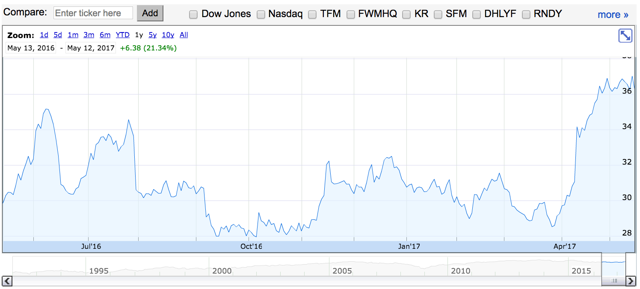Summary
The company has no credible plan to reverse the customer loss to Kroger.
The company is not likely to be acquired by its competitors.
Whole Foods' trailing earnings multiple is priced like a growth stock but its performance is declining.
Whole Foods (NASDAQ:WFM) reported second quarter earnings on May 10th which should have disappointed investors. Rather than drop, the stock price rose the next day by over 2%. The stock is now trading near its 52 week high.
In the paragraphs below I'll show why investors in Whole Foods are irrationally exuberant and the stock is over priced.
Customer Loss
Earlier this year, Karen Short of Barclays stated that Whole Foods has lost millions of customers over the past 18 months and Kroger (NYSE:KR) has likely been the biggest beneficiary.
During the earnings release, Whole Foods announced an additional $300 million cost savings that would be completed by fiscal year 2020. The company also announced that savings from improved data analytics and unified category management will be used to reduce prices.
While undoubtedly a positive step that will help Whole Foods' shed its Whole Paycheck image, I do not believe the company can regain the customers it lost to Kroger, Publix, Sprouts (NASDAQ:SFM), etc.
In November 2015, BusinessInsider completed a price comparison for an identical set of groceries (including organics) at Whole Foods and Kroger. The author found a customer would spend $131 at Kroger and $191 at Whole Foods. Whole Foods would have to reduce prices by ~30% to be price competitive with Kroger. I do not foresee this happening.
Even if Whole Foods can price match Kroger it has not addressed the convenience factor. A shopper can now make a single trip to a Kroger, Publix, etc and purchase organic groceries along with packaged goods like Persil detergent, soaps, toiletries, air fresheners, etc.
The limited selection at Whole Foods may require the same shopper to also visit another store for those goods not found at Whole Foods. Grocery shopping is more convenient at larger stores than it is at Whole Foods.
Whole Foods is no longer the only retailer offering organic goods.
Acquisition
Much of the Whole Foods mania today is centered around the hopes of an acquisition. I find the likelihood of an acquisition to be fairly low. Let's walk through a few possible suitors for Whole Foods.
Amazon (NASDAQ:AMZN) - Bloomberg reported that Amazon thought about an acquisition in fall of 2016 but did not pursue it. I find it unlikely that Amazon will now pursue an acquisition after the stock has appreciated 18%.
Wal-Mart (NYSE:WMT) - The retail behemoth seems to be more focused on challenging Amazon with numerous eCommerce acquisitions. An acquisition by Wal-Mart seems unlikely.
Kroger - Kroger's market capitalization is only $28 billion. Acquiring Whole Foods ($12 billion market cap) would be very expensive. Kroger seems to be beating Whole Foods; why would they need to take a large amount of debt to acquire them?
Albertsons - Albertsons is reportedly in discussions to acquire Whole Foods competitor Sprouts Farmers Market. Sprouts is significantly smaller (and cheaper) than Whole Foods.
Private Equity - Over the past two years, private equity firms have acquired The Fresh Market ($1.36 billion - Apollo) and Save-A-Lot ($1.365 billion - Onex). A Whole Foods acquisition would be significantly more expensive. Cerberus (Albertsons) had paid $9 billion when it acquired Safeway in 2014.
Why would a private equity firm now show interest in Whole Foods with price having appreciated 18%?
Irrational Valuation
The most troubling part of Whole Foods' earnings release was the continuing decrease in comparable store sales.
The table below shows Whole Foods' comparable store sales for the past seven quarters.
| Period | Comp Store Growth | Source |
| 2017 Q2 | (2.5%) | Link |
| 2017 Q1 | (2.4%) | Link |
| 2016 Q4 | (2.6%) | Link |
| 2016 Q3 | (2.6%) | Link |
| 2016 Q2 | (3.0%) | Link |
| 2016 Q1 | (1.8%) | Link |
| 2015 Q4 | (0.2%) | Link |
The comparison period for 2017 Q2 is 2016 Q2 which had a 3% decline in comparable store sales. Whole Foods has not reported positive comparable store sales in seven quarters.
Even with this seven quarter streak of declining same store sales, Whole Foods trades at 26 trailing earnings multiple.
How does the Whole Foods earnings multiple compare to other retailers and non-retailers?
| Whole Foods | 26.24 | Target (NYSE:TGT) | 12 |
| Alphabet - Google (NASDAQ:GOOG) | 30.79 | Dollar General (NYSE:DG) | 16 |
| Kroger | 14 | CVS (NYSE:CVS) | 16 |
| Wal-Mart | 17 |
Whole Foods' has nearly the same trailing earnings multiple as Google, an almost double multiple versus Kroger, CVS, Dollar General and a more than double multiple versus Target.
I find it irrational that even with seven consecutive quarters of declining comparable sales, Whole Foods trades at an earnings multiple that is nearly on par with a tech growth company (Alphabet) and higher than its retailers peers Kroger, Wal-Mart, etc.
Conclusion
In conclusion, I believe Mr. Market is irrationally valuing Whole Foods. The company is unlikely win back the customers it has lost to Kroger, Publix, etc. The average basket price will likely be lower at larger grocers than Whole Foods. The probability of an acquisition is likely low as Wal-Mart is more focused on eCommerce and Kroger would have to issue a lot of debt to acquire a company they are currently winning customers from. Finally, even with eroding comparable sales growth, investors have given Whole Foods a trailing earnings multiple significantly higher than other retailers and nearly on par with Google.
Contrarian
Whole Foods has initiated a few programs that may improve performance:
- The company's loyalty card will help collect data to better understand shopping habits.
- Cost cuts and the new 365 stores will help lower prices.
- The company's brand name is still very valuable.


No comments:
Post a Comment